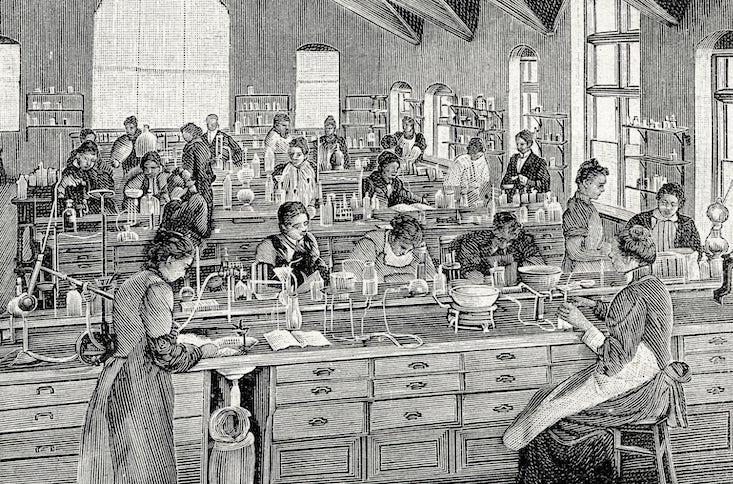
The increasing visibility of women in leadership roles is one of the few success stories in the struggle for equality in science. But a new study, which connects how often scientists’ later publications get cited with the gender of their early coauthors, threatens to throw cold water on even that modest success. The authors, computer science and public policy researchers at New York University Abu Dhabi, two of whom are women, claim the evidence is clear that having women as mentors is harmful to their mentees’ long-term citation rates. The paper, published in Nature Communications, goes on to suggest that working with senior women coauthors is perhaps best avoided, especially by junior women scientists, because it could leave a stain that marks a researcher for her academic life and diminishes her overall “scientific impact.” Diversity policies specifically “promoting female-female mentorships, as well-intended as they may be,” the authors write, “could hinder the careers of women who remain in academia in unexpected ways.”
It would take a stronger word than “controversial” to describe this paper adequately, in part because the scientists in its target audience are also its subjects. An open letter with 17,000 likes on Twitter called for it to be retracted “for the good of the global scientific community.” Scientists across disciplines have threatened to stop reviewing for the journal. Many have also pushed back against calls for retraction, recommending that comments on the paper’s alleged flaws be submitted to the journal instead. And this idea has, of course, itself received criticism for being an ineffective half-measure. (The journal’s editors have added a note that they are “investigating the concerns raised” by the paper and planning an editorial response.)
To recap where things stand in the year 2020: For a variety of reasons, including cultural and structural impediments, far more men than women today have careers in science, technology, engineering, and mathematics (STEM). In the United States, only one in three bachelor’s degrees in physical sciences, engineering, and computing go to women, and fewer than one in five doctoral degrees in those fields. This can create a feedback effect: the fewer women there are, the harsher the environment can be for those who remain. Women in male-dominated scientific fields are subject to insults and abuses ranging in severity from subtle verbal cues, like their employers using male pronouns to refer to potential new hires, to outright sexual harassment and employment discrimination. Even once established in their careers, female academics are paid less than their male counterparts, cited less often, and expected to do more time-consuming service work, like participating in committees. Recent research has shown that female mentors may help address some—but certainly not all—of these problems. Contact with a woman in a more advanced role inoculates younger women against threats to their scientific identity and reinforces that perhaps they, too, can thrive in science.
The paper’s advice could even make matters worse.
According to the new mentorship study, though, this may come at a cost to their careers. The authors considered a database of over 200 million scientific publications from which they identified 3 million mentor-mentee relationships, defined by one coauthor being within the first seven years of their career and another being outside that period. Then they measured the subsequent publication impact of the mentees according to how often their papers were cited on average. Using a matching algorithm, they found (among other things) that, all else being equal, a scientist’s impact was smaller the more women they had as mentors. (Using similar methods, two of the three authors, in a 2018 study, found that ethnic diversity among research collaborators positively affected their scientific impact.)
Critics have highlighted many potential issues with the mentorship study. There is a definitional problem: Equating mentorship with coauthorship gives an incomplete picture that ignores the mentoring work not involving publications done by women in academia. There are data issues: The database encompasses over 200 years of publications, so it likely reflects gender bias that’s (hopefully) less strong than it once was. More notably, it doesn’t actually include gender identity, so the study used a machine-learning approach to discern gender based on authors’ first names; (as someone whose name comes up as 53 percent likely to be male, according to the algorithm, I may be especially sensitive to this point.) The paper also suggests a causal link between citation rates and mentors’ gender, meaning an individual can improve their expected impact by choosing a male mentor over a roughly equivalent female one. But the data are purely observational, allowing for many other possible explanations for the observed association.
The study controls for several possibly confounding variables: mentors’ citation impact (female mentors themselves would historically be associated with lower citation rates), number of mentors for a given mentee, year of first publication, rank of the mentee’s degree-granting institution, scientific discipline, and others. So, while not being a randomized controlled trial, it perhaps comes about as close as possible to establishing that causal link from the historical record.
What’s upset many scientists about the study is not so much its methodological flaws, nor the finding that the above causal link exists, but rather the hinted-at conclusion for what should be done about it. It’s plausible that coauthoring with female mentors could put a dent in a scientist’s citation numbers for the same reason that being a woman puts a dent in them—bias against women within the academic community. So, it may seem pragmatic to avoid coauthoring too much with women. But this represents a surrender to sexism and a cynical acceptance that such bias should be taken as a given.
It’s also not a conclusion that follows immediately from the data analysis of the paper. Instead, it’s a policy-minded interpretation and recommendation that reflects a particular worldview. As I argued recently in Nautilus, there is an illusion that’s long plagued science—linked to the eugenics movement and the ideas of Francis Galton, the founder of Nature—that objectivity in statistical analysis confers objectivity in interpretation. What’s being measured may be a fact of the world, but what it implies for our decision making depends heavily on our perspective.
For example, if you cut out the abstract and conclusion, the Nature Communications paper could have easily been titled, “Evidence for gender bias in citation rates for senior and junior coauthors in science publications.” That is to say, the paper’s findings are as consistent with a different recommendation than the authors offered—that citation bias extends further than we might previously have thought, and we should work to root out this bias against women mentors and their mentees.
By making it more difficult for women to recruit any coauthors—a crucial ingredient for their career success—the paper’s advice could even make matters worse. As a biologist at McGill University put it, “Imagine if there was a study that found evidence of bias against women in grant review and concluded that, based on that, universities shouldn’t hire female faculty. That’s what this Nature Comms paper does.”
What’s more, by including only the women in science who successfully published papers, the study elides the fact that too few women make it that far because many find academic science inhospitable. Strategically choosing a male coauthor instead of a female one might never have been an option. It’s the equivalent of studying whether milk pasteurization harms the immune systems of children without mentioning the many children before pasteurization was invented who didn’t live long enough to be studied.
When toxic work environments, implicit bias, and a host of other obstacles no longer cause so many women to leave science, we should revisit the question of how best to divvy up mentoring responsibilities. In the meantime, arguably the best prescription to improve the situation facing women in science is for there to be more women in science.
Aubrey Clayton is a mathematician living in Boston and the author of the forthcoming book Bernoulli’s Fallacy.


























